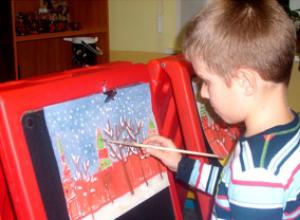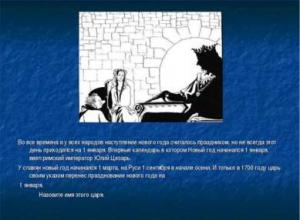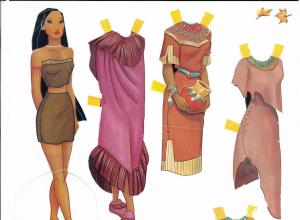The most interesting facts about Easter. Interesting facts about Easter Briefly interesting facts about Easter
The egg is the main symbol of Easter, which means new life and rebirth for Christians. That is why it is an obligatory element of many Easter customs and games. The custom of giving each other colored eggs was not invented by Christians. This was also done by the ancient Egyptians and Persians, who exchanged them as part of the celebration of the beginning of spring. Eggs then meant a wish for fertility.

In medieval Europe, there was a tradition of giving eggs to servants on Easter. In addition, they were presented to each other by lovers as a sign of romantic sympathy. Easter eggs are usually painted in bright colors. The most popular is red or purple which symbolizes the sacrificial blood of Christ. According to legend, Mary Magdalene presented an egg of exactly this color to Emperor Tiberius with the words: "Christ is Risen!". Other favorites are rich yellows and greens that evoke spring sunshine and greenery.

Nowadays Easter eggs are painted in a variety of colors, not just sacred ones. They are also often decorated with various designs and ornaments. There are several ways to create a pattern on the shell. For example, you can tie some kind of carved leaf, like a fern, to the egg before dyeing to get a beautiful pale outline against a bright background of the main color. To make pysanka, beeswax is used, which is applied in certain places to the shell, after which the eggs are immersed in a solution of food coloring.

To obtain a particularly complex and multi-colored pattern, several paints are used, and before each immersion, a new wax contour is applied to the surface of the shell, under which the previous shade is preserved. To give eggshells different colors, you can use onion peels, instant coffee, blueberry, cranberry and grape juice, beetroot broth and even violet petals.

EASTER RABBIT.

A rabbit (or hare) is as integral an attribute of the Easter holidays as a painted egg. Like the egg, this animal symbolized fertility in many ancient cultures, which is not surprising given its phenomenal ability to reproduce quickly and abundantly. It is not entirely clear why the rabbit became associated with Easter. One version says that it signifies the prosperity that awaits followers of the teachings of Christ.
In many countries, children believed (and still do) that, subject to exemplary behavior on their part, the Easter Bunny comes on the eve of the holiday and lays colored eggs in the nest. The nest (or basket) had to be prepared in advance in a secluded place. Kids usually used their hats for this purpose, laying them out in barns, barns and other secluded rooms. The arrival of the miracle rabbit was awaited with almost the same impatience as the visit of Santa Claus.

All of Germany eats chocolate bunnies and chocolate eggs on Easter. At Easter, rabbits in Germany lay eggs. And these days, the rabbit has become a symbol of Easter. An interesting career for this animal. After all, at first the church fathers denied the rabbit. It was believed that its meat suggested quick thoughts. Scientists have long argued about the origin of the hare as a symbol of Easter. Some believed that the rabbit was a symbol of fertility of the ancient German goddess Ostera, others believed that it was a Byzantine symbol of Jesus.
There were no Easter eggs in the evangelical church because there was no fasting. Eggs could also be eaten before Easter. And since eggs were not an element of the sacred meal, they received other uses. They were brightly painted and hidden in the garden. Then someone was needed to hide these eggs. A character similar to Saint Nicholas or the Christ Child arose. And it was the Easter Bunny.
Then the search for Easter eggs became known as the Easter Bunny hunt. Whoever found the blue egg first was in for trouble. A red egg meant three days of good luck. Even in the Goethe family in Weimar such Easter games took place. Soon stories related to the hare arose.

The best Easter bunny is the one with the bell hanging around his neck. On the eve of Easter, this eared character can be found everywhere and in different forms. Rabbits are made from chocolate, marzipan and other tasty materials, they are sewn from plush and fur, and sculpted from clay. “Rabbit” ornaments decorate many Easter items: holiday tablecloths, napkins, dishes. And, of course, postcards.
EASTER LAMB.

It is interesting that even in pre-Christian times, Jews, celebrating the spring festival of Passover (it is from this name that the word Easter comes), sacrificed lambs. The early Christians did not forget this custom, but gave it a different meaning. Now the sacrificial lamb symbolized the meek death of Christ.
Thus, it is quite understandable why roast lamb takes pride of place on the Easter table of many Europeans. In Russia, instead of this “bloody” dish, they serve harmless Easter cottage cheese.
EASTER CANDLE.

The tradition of placing a large candle at the altar during the Easter night service exists in all Christian countries. All other lamps in the church are then lit from this candle. The ritual originated in the 4th century AD, with the main candle being a symbol of Jesus Christ and its sacred flame a symbol of the Resurrection.
In the old days, parishioners took home candles with blessed fire in order to use them to light home lamps and light hearths. This custom symbolized the sacrifice of Christ, who gave his life for the sake of people.


Photo: internet
What do you know about Easter - one of the most ancient and revered religious holidays today? There are a huge number of legends associated with it, many mythical stories and simply interesting events that, we are sure, will not leave you indifferent. Dni.Ru offers a selection of impressive facts about Easter.
Did you know that...
The word "Easter" is associated with the Jewish holiday of Passover (translated from Hebrew - to pass, step over, pass by) in memory of the liberation of the Israelites from Egyptian slavery.

After the New Year and the joy of one’s own birthday, Easter takes 3rd place in the ranking of the most popular holidays in Russia.
The most famous works of art dedicated to the Easter holiday are the Easter eggs of the jeweler Carl Faberge, which he created annually by order of Emperor Alexander III himself in honor of his wife Maria. Each egg took a year to make from gold and precious stones, and also had to have a surprise inside.
Due to the difference between the Gregorian and Julian calendars, the Catholic and Orthodox churches celebrate the holiday at different times, only in 30% of cases the date of Easter coincides, and in as many as 45% of cases the Catholic celebration occurs a week earlier.

The authorities of Great Britain, Canada, Germany, Portugal and many other European and Latin American countries have made Good Friday an official holiday. In schools and universities in most countries, Easter is a two-week holiday.
Christian teaching tells us that Easter cake is a symbol of church domes, and Easter is a symbol of the Holy Sepulcher. However, this type of treat appeared long before the birth of Christianity and was widespread in Rus' during pagan times. People baked Easter cakes and Easter cakes as a gift to the gods of spring and fertility in order to appease the heavenly powers. Cottage cheese pie together with bread thickly greased with egg whites symbolized the masculine and feminine principles among the Slavs.

According to the official biblical version, the custom of painting eggs came from the Roman Empire. Thus, Mary Magdalene, a disciple of Jesus Christ, allegedly came to Emperor Tiberius with a lesson in faith - she gave him a chicken egg in honor of the resurrection of her teacher. He did not believe it, and before his eyes the egg turned blood-red, forcing the emperor to change his mind. Well, modern scientists put forward a different version. As you know, during the 40-day fast, neither meat nor eggs could be eaten, and the chickens continued to lay eggs. To prevent food from being wasted, peasants boiled eggs in onion skins, so as not to confuse old ones with fresh ones. This is how the tradition of making dyes for Easter arose.
The world's largest Easter egg is located in Canada in the city of Vegreville - weighing almost 2 tons and 8 meters in height! In Russia, the largest Easter egg was created from ice; its mass was about 900 kg.

In order for the date of the resurrection of Christ to take root in Rus', churchmen timed it to coincide with the Red Hill holiday, popular among the Slavs. It was on this day that the peasants welcomed the arrival of spring and exchanged Easter eggs, worshiping the goddess Lada, and also buried funeral dinners on the graves of deceased relatives. So two different holidays were intertwined together.
The Catholic symbol of Easter is the rabbit, the roots of whose worship came from the beliefs of the ancient Celts, who considered this animal a symbol of fertility. To amuse children, Europeans still have a tradition of hiding nests with chocolate rabbit eggs in the meadow, which need to be found.
In America, the most common Easter tradition is rolling eggs on the lawn of the presidential palace. The massive competition is usually held on the White House lawn, where hundreds of children with Easter baskets vie to see who can roll their egg the farthest.

The most popular American sweets for the Easter holidays are Marshmallow Peeps - colored marshmallows in the shape of rabbits, birds and chickens. Over the weekend season, they sell more than 700 million copies.
The actions in the novel “The Master and Margarita”, as conceived by the unsurpassed Bulgakov, take place just during Holy Week, and the story ends on the eve of Easter night.
On the day of Jesus' crucifixion on the cross - Good Friday - Christian temples and churches stop ringing their bells. The tradition of silence lasts two days while the body of the Savior is mourned. And on Sunday morning the bell ringing solemnly returns, marking the resurrection of the Son of God and the holiday in honor of the good news.
Only 1% of Russians observe Lent in all its strictness - they go to church, read prayers and limit themselves in food. Another 21% adhere to certain limits, denying themselves small joys. However, this does not prevent almost all of us from celebrating Easter, honoring each other with dyes and Easter cakes.
Orthodox Christians are preparing to celebrate the bright holiday - Easter. This is the main event of the year for Orthodox Christians. The word “Easter” came to us from the Greek language and means “passing”, “deliverance”. On this day, believers celebrate the deliverance through Christ the Savior of all mankind from slavery to the devil and the gift of life and eternal bliss.
As theologians note, just as redemption was accomplished by the death of Christ on the cross, so by His Resurrection eternal life was granted to people.
Today we know many of the customs of celebrating Easter: Christening, etc., but there are some facts that may be of interest even to people who profess a different faith or are not believers at all. We invite you to read this collection.
Interesting facts related to Easter:
The custom of giving each other colored eggs was not invented by Christians. This was also done by the ancient Egyptians and Persians, who exchanged them as part of the celebration of the beginning of spring. Eggs then meant a wish for fertility.
The most famous Easter eggs were made by Peter Carl Faberge - back in 1883, Tsar Alexander ordered a gift set of such eggs for his wife.
The largest Easter egg is located in Vegreville, Alberta, Canada. It weighs about 2 tons and its length is about 8 meters.
In Russia, the largest Easter egg was made from ice in 2010. Its weight was 880 kilograms and its height was 2.3 meters.
Eggs are painted on Maundy Thursday, just like Easter cakes are baked. At the same time, it was customary to make Easter - a dish made from cottage cheese.
The ceremony of bringing out the Holy Light on Holy Saturday is carried out jointly by the Greek and Armenian patriarchs of Jerusalem.
The world's largest Easter cake, weighing more than 2 tons and 2.4 meters high, was baked in 2011 in the village of Yalta, Donetsk region.
In Russia, painted Easter eggs or pysanky were kept at home throughout the year, thus protecting their home from fires, floods and other natural disasters.
In Kolomyia there is a Pysanka Museum, the building was built in the shape of an egg.
During Holy Week, myrrh is prepared only once a year - a special mixture of several dozen substances based on olive oil, aromatic herbs and fragrant resins.
In Russia, in the old days, it was customary for housewives to stay at home on the first day of Easter, and men to go to their loved ones and acquaintances with congratulations. The tables had been set all day and there were already fast (non-lenten) dishes on them. The Easter table was usually decorated mainly with cold dishes: baked lamb, fried veal, pork hams. It was not customary to serve fish on this day.
In addition, some Russians visit the graves of relatives on Easter. However, this is not welcomed in the Orthodox Church. As the holy fathers note, in connection with the joyful day of Easter, the commemoration of the dead ceases for the entire Bright Week. Relatives are called to remember on Radonnitsa (Parents' Day)
In the Russian Orthodox Church there is a custom to read the first 17 verses of the Gospel of John in various languages at the festive Easter service.
In 45% of cases, Catholic Easter is a week earlier than Orthodox Easter, in 30% of cases it is the same, in 5% there is a difference of 4 weeks, in 20% there is a difference of 5 weeks.
In 2014, Catholics celebrated Easter together with Orthodox Christians.
Of the former USSR countries, only in Belarus are both Catholic and Orthodox Easter considered state holidays.
The English name for Easter, Easter, comes from the Anglo-Saxon goddess of the dawn, Eostre. In our country this goddess is better known under the name Ishtar (and the corresponding Greek name Hestia, German Eostre, Ostarta, Lithuanian Austra)
For Catholics, the symbol of Easter is the rabbit. In many European countries, children believe that, subject to exemplary behavior on their part, the Easter Bunny comes on the eve of the holiday and lays colored eggs in the nest. The nest (or basket) had to be prepared in advance in a secluded place. Kids usually used their hats for this purpose, laying them out in barns, barns and other secluded rooms. The arrival of the miracle rabbit is awaited with almost the same impatience as the visit of Santa Claus.
The best Easter bunny is the one with the bell hanging around his neck. On the eve of Easter, this eared character can be found everywhere and in different forms. Rabbits are made from chocolate, marzipan and other tasty materials, they are sewn from plush and fur, and sculpted from clay. “Rabbit” ornaments decorate many Easter items: holiday tablecloths, napkins, dishes. And, of course, postcards.
76 percent of Catholics eat chocolate bunnies' ears first.
In America, a very common Easter game is rolling eggs on a sloping lawn. The winner of the competition is the one who can roll his colored egg the farthest without stopping. The most popular competition takes place on Easter Sunday on the lawn near the White House in Washington. Hundreds of children come here with their Easter baskets filled with brightly colored eggs and roll them down the lawn near the presidential palace.
Sweden has its own kind of fun. They even have Easter Witches. Little girls dress in rags and old clothes, most often their outfits consist of oversized skirts and scarves. In this form, the girls go from door to door with a copper teapot and collect treats. They say this custom originated from the ancient belief that witches fly to the German mountain Blockula on the Thursday before Easter and hold a Sabbath. According to legend, when they returned back, the ancestors of the Swedes and Finns lit fires and scared the evil spirits. People also shot into the air and painted crosses on houses and barns to scare away evil spirits. Nowadays, the tradition is alive: in the days before Easter, Swedes and Finns light bonfires and set off fireworks.
At Easter, Bulgarians make a huge amount of clay products, most often pots, which are usually thrown on the same day from the upper floors of houses to the ground: this marks the victory of good over evil. At the same time, every passerby can take a clay fragment with them - for good luck.
And in a number of Latin American countries and some parts of Greece, it is customary to hang an effigy of the apostle who betrayed Christ and burn it. Sometimes fireworks are placed in the effigy.
The word "Easter" came to us from the ancient Greek language. It is based on the Hebrew word xaseP (Pesach). However, some researchers believe that the name of the holiday has nothing to do with the Jews. They explain this by the presence in ancient Greek of the verb pa/sxw (passho), which stands for “to suffer.”
Easter date
According to existing tradition, Orthodox Christians celebrate Easter on the first Sunday after the spring full moon. Moreover, in 45% of cases, Catholic Easter is celebrated a week earlier than Orthodox Easter.
The tradition of dyeing eggs for Easter
According to one legend, the tradition of painting eggs for Easter is associated with the name of Emperor Marcus Aurelius. On the day he was born, one of the hens laid an egg marked with red dots. This was interpreted as the birth of a new emperor. And since 224, the Romans have had a tradition of sending each other colored eggs as congratulations.
The largest Easter egg
The largest Easter egg in the world is considered to be the egg located in the Canadian city of Vegreville. Its weight is two tons and its length is about eight meters.
Easter cake
Kulich is an indispensable attribute of Easter, the history of which dates back to pagan times. Many peoples had a custom of baking bread in the spring and bringing it as a gift to the land. Thus, our ancestors thanked the fertility gods for the harvest.
Catholic Easter symbol
One of the main symbols of Catholic Easter is the rabbit. In many European countries, children believe that it is the Easter Bunny who brings sweet gifts and eggs to the house.
Good deeds
On Easter days, it is customary not only to give gifts, but also to do charity work. Since ancient times, special attention has been paid to orphans and elderly people.
Easter fairs
Long before Easter, holiday fairs open in many cities. Traditionally, here you can buy not only delicious treats, but also goods made by folk craftsmen.

Easter game
In the USA, there is an interesting Easter game - rolling eggs on a sloping lawn. For many years, the largest competition has been held on the grounds of the White House with the participation of the presidential family.
Clay pots
An unusual Easter tradition exists in Bulgaria. Here it is customary to throw clay pots from the windows. Thus, the inhabitants of the country celebrate the victory of good over evil. At the same time, every passerby can take a shard from a broken pot for good luck.
Orthodox Easter is one of the most ancient holidays. It is preceded by a long fast, requiring restrictions on food intake. The constant symbols of this holiday are colored eggs, Easter and Easter cakes.
Orthodox Easter in 2018: traditions, customs, signs of celebration
The time of Easter changes every year, shifting by one or more days, but a mandatory condition for the holiday is Sunday.
Service is another indispensable condition of Easter. The ceremony begins at twelve o'clock at night Moscow time on Saturday and ends on Sunday.
For all believers, Easter is of great importance; full of light and warmth. “Christ is risen” - this is how people greet themselves on this great day.
Orthodox Easter in 2018
For true believers, celebrating Easter requires a lot of preparation. The celebration of this significant event itself lasts for forty days. This is connected with the forty-day stay of the Risen Lord on earth. Easter is important for both Catholics and Orthodox people.
It marks victory over death, life. On such a day, the church is especially pleased to welcome all parishioners. A large number of Easter cakes, colored eggs - all this expanse is evidence of love for life, eternal existence.

As mentioned above, the date of Easter changes every year. The only thing that remains unchanged is Sunday. This inconstancy is associated with the solar-lunar calendar. Calculating the time of Easter next year on your own is quite difficult.
They certainly use various calendar systems for this, determining the time of one of the most significant church holidays in advance.
Signs and traditions of the holiday
Easter is one of the oldest holidays and therefore the number of its traditions is also quite large. The indispensable symbols of Easter (Easter cakes, colored eggs) were not chosen by chance. Eggs and Easter cakes are meant to symbolize life, water is the personification of Easter streams.

The Holy Fire is another invariable attribute of the holiday. As soon as Easter night arrived in all towns and villages, people went to church, listened to the service, lit water and a basket, certainly filled with Easter products.
After the end of the service, all parishioners went home, where they set the festive table and began to eat. They ate the egg first, then the Easter cake, and only then the other dishes presented on the table.
It is also worth noting that before such expanse, strict fasting was mandatory, lasting as long as 48 days and requiring abstinence from certain types of food.
One of the favorite Easter pastimes has always been the battle of eggs. To do this, two people took an egg in their hand and struck the enemy’s egg. The one whose egg remained intact was considered the winner.

The unchanging tradition of the Orthodox Easter holiday, preserved to this day, is to greet everyone with the words: “Christ is Risen,” to which the opponent should respond: “Truly He is Risen.”
This is how people greet each other and at the same time congratulate each other on the holiday.
Signs of the holiday also deserve special attention
Since ancient times it has been known:
The first one to come home after the end of service is lucky for the whole next year;
If you pass an Easter egg over the faces of children, it means to protect them from the evil eye;
You can bring success and wealth into your life by dipping gold jewelry into water with a blessed Easter egg.
Easter rituals
In 2018, Orthodox Easter falls on April 8 and the Catholic one will be celebrated a little earlier - April 1. Each holiday will have a specific symbol. For example, for Catholics it will be red eggs (precisely red, without additional drawings or paintings). Central Europe and its inhabitants always paint eggs and add interesting designs to them.
Another symbol of the Catholic holiday is the hare. Souvenirs and even baked goods in the shape of this animal can be found in all stores.
Family dinner is another integral Easter tradition. At the same time, attention is focused not only on the dishes presented, but also on the decoration of the festive table itself.
Dishes for Easter
After Lent, when believers restrained themselves from eating food in every possible way, they are allowed to eat meat dishes on Easter. In addition to traditional Easter cakes and eggs, it is customary to bake lamb from bread.
In total, according to tradition, there should be 48 different treats on the table. Housewives come up with new recipes, trying to surprise their guests every year.
Most common dishes:
- Curd Easter;
- Stuffed tomatoes;
- Baked lamb or veal;
- Aspic;
- Herring under a Fur Coat;
- Spring salad;
- Crab stick salad;
- Any meat and fish dishes (at the request of the housewife);
- Liqueurs, wine;
- Various pickles.
Having eaten to their heart's content, in the evening people go out into the streets, sing songs, glorify Jesus, and dance. A bright holiday settled in the souls of believers and illuminated their faces with joy and happiness.
What not to do on Easter
Orthodox Easter is a time when it is forbidden to do any household chores. Weddings are not allowed on Easter days and a few days before it. This ban is associated with the need for spiritual and moral cleansing in the coming days.
The bright and pure holiday of Orthodox Easter is a wonderful time when everyone has the opportunity to cleanse their body and mind, become more soulful and open.
*****************
Easter in 2018. History, description, Easter recipes
******************
Easter: history of the holiday, Easter traditions, rules...
The egg is the main symbol of Easter, which means new life and rebirth for Christians. That is why it is an obligatory element of many Easter customs and games. The custom of giving each other colored eggs was not invented by Christians. This was also done by the ancient Egyptians and Persians, who exchanged them as part of the celebration of the beginning of spring. Eggs then meant a wish for fertility.

In medieval Europe, there was a tradition of giving eggs to servants on Easter. In addition, they were presented to each other by lovers as a sign of romantic sympathy. Easter eggs are usually painted in bright colors. The most popular is red or purple which symbolizes the sacrificial blood of Christ. According to legend, Mary Magdalene presented an egg of exactly this color to Emperor Tiberius with the words: “Christ is risen!” Other favorites are rich yellows and greens that evoke spring sunshine and greenery.

Nowadays Easter eggs are painted in a variety of colors, not just sacred ones. They are also often decorated with various designs and ornaments. There are several ways to create a pattern on the shell. For example, you can tie some kind of carved leaf, like a fern, to the egg before dyeing to get a beautiful pale outline against a bright background of the main color. To make pysanka, beeswax is used, which is applied in certain places to the shell, after which the eggs are immersed in a solution of food coloring.

To obtain a particularly complex and multi-colored pattern, several paints are used, and before each immersion, a new wax contour is applied to the surface of the shell, under which the previous shade is preserved. To give eggshells different colors, you can use onion peels, instant coffee, blueberry, cranberry and grape juice, beetroot broth and even violet petals.


EASTER RABBIT

A rabbit (or hare) is as integral an attribute of the Easter holidays as a painted egg. Like the egg, this animal symbolized fertility in many ancient cultures, which is not surprising given its phenomenal ability to reproduce quickly and abundantly. It is not entirely clear why the rabbit became associated with Easter. One version says that it signifies the prosperity that awaits followers of the teachings of Christ.

In many countries, children believed (and still do) that, subject to exemplary behavior on their part, the Easter Bunny comes on the eve of the holiday and lays colored eggs in the nest. The nest (or basket) had to be prepared in advance in a secluded place. Kids usually used their hats for this purpose, laying them out in barns, barns and other secluded rooms. The arrival of the miracle rabbit was awaited with almost the same impatience as the visit of Santa Claus.

All of Germany eats chocolate bunnies and chocolate eggs on Easter. At Easter, rabbits in Germany lay eggs. And these days, the rabbit has become a symbol of Easter. An interesting career for this animal. After all, at first the church fathers denied the rabbit. It was believed that its meat suggested quick thoughts. Scientists have long argued about the origin of the hare as a symbol of Easter. Some believed that the rabbit was a symbol of fertility of the ancient German goddess Ostera, others believed that it was a Byzantine symbol of Jesus.

There were no Easter eggs in the evangelical church because there was no fasting. Eggs could also be eaten before Easter. And since eggs were not an element of the sacred meal, they received other uses. They were brightly painted and hidden in the garden. Then someone was needed to hide these eggs. A character similar to Saint Nicholas or the Christ Child arose. And it was the Easter Bunny.

Then the search for Easter eggs became known as the Easter Bunny hunt. Whoever found the blue egg first was in for trouble. A red egg meant three days of good luck. Even in the Goethe family in Weimar such Easter games took place. Soon stories related to the hare arose.

The best Easter bunny is the one with the bell hanging around his neck. On the eve of Easter, this eared character can be found everywhere and in different forms. Rabbits are made from chocolate, marzipan and other tasty materials, they are sewn from plush and fur, and sculpted from clay. “Rabbit” ornaments decorate many Easter items: holiday tablecloths, napkins, dishes. And, of course, postcards.


EASTER LAMB

In many Christian countries, Easter is also associated with the image of a lamb. On themed cards he is often depicted next to a cross and the inscription "Agnus Dei" (Lamb of God).

It is interesting that even in pre-Christian times, Jews, celebrating the spring festival of Passover (it is from this name that the word Easter comes), sacrificed lambs. The early Christians did not forget this custom, but gave it a different meaning. Now the sacrificial lamb symbolized the meek death of Christ.

Thus, it is quite understandable why roast lamb takes pride of place on the Easter table of many Europeans. In Russia, instead of this “bloody” dish, they serve harmless Easter cottage cheese.

EASTER CANDLE
The tradition of placing a large candle at the altar during the Easter night service exists in all Christian countries. All other lamps in the church are then lit from this candle. The ritual originated in the 4th century AD, with the main candle being a symbol of Jesus Christ and its sacred flame a symbol of the Resurrection.

In the old days, parishioners took home candles with blessed fire in order to use them to light home lamps and light hearths. This custom symbolized the sacrifice of Christ, who gave his life for the sake of people.

Latest site materials
Health

Mental development of a preschooler About the mental activity of preschoolers
PAGE_BREAK--The use of spatial models also turned out to be extremely effective when teaching preschoolers to analyze the sound composition of a word.
Horoscope

Lesson from the world around us
Lesson about the world around us "winter holidays" Winter New Year
Health

Outline of the world around us Topic: Winter holidays Purpose: to introduce the common and different features of the Christmas holiday in Western countries and Russia (past and present), with the origin and features of the winter New Year holiday Pl
Two children and a frozen pregnancy: will it be possible to give birth this time?
Cooking

Hello, I’m 28 years old and I’ve had 2 frozen pregnancies! And now it’s just been more than six months since the second, I’ve had a bunch of tests for genetics, infections, hormones, and my gynecologist says it’s time to try again, but I just can’t get over my fear( (
July 7th, 2016 Located in Western Australia, the Super Pit mine is also one of the largest and most famous. It produces more than 780,000 ounces of gold annually for its owners, Newmont Mining and Barrick Gold. Super Pete yavl
Cooking

Paper doll with clothes: detailed master class
Here you can print and make paper dolls for children and coloring pages for free. They are suitable both for games at home and for games in kindergartens and early development schools. Here are collected not only images of dolls with outfits, the image of a princess, but also
Horoscope

The perinatal period of its development starting
A person’s entire life is divided into certain periods, each of which has its own characteristics. The perinatal period is considered one of the important periods of life. What time frame does it fit into, and what physiological and psychological changes?